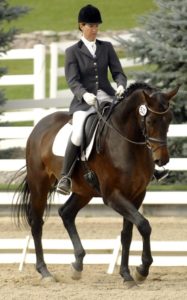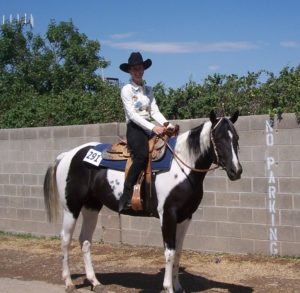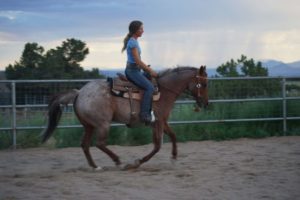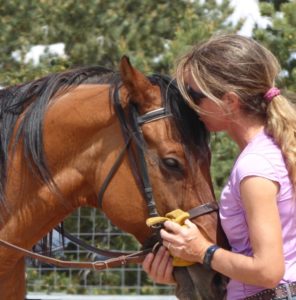Katrin Silva grew up riding dressage in Germany before moving to the United States at age 19 to  learn to ride Western. She’s been riding both disciplines for the last twenty years.
learn to ride Western. She’s been riding both disciplines for the last twenty years.
Silva has competed successfully through fourth level dressage on quarter horses, Morgans, Arabians, Hanoverians, and many other breeds. Based in New Mexico, she enjoys improving horse-rider partnerships of all sorts and firmly believes that good riding is always good riding, no matter which type of tack a horse is wearing. Check out her blog here.
Katrin Silva writes:
I’ve done some things I’m not proud of early in my career as a horse trainer. I made mistakes because I wanted quicker results and because I was too young to know better. Two decades on, I’m still human and not immune to making mistakes, but I keep a couple of sacred cows in my training philosophy.
 Of my limited understanding of Hinduism, I know that sacred cows are strictly off-limits. A sacred cow can lie down in the middle of a city street and take a nap. Traffic goes around or stops altogether. Disturbing the cow is not an option because that would lead to bad karma.
Of my limited understanding of Hinduism, I know that sacred cows are strictly off-limits. A sacred cow can lie down in the middle of a city street and take a nap. Traffic goes around or stops altogether. Disturbing the cow is not an option because that would lead to bad karma.
I know horses a lot better than Hinduism, but I navigate around these Three Sacred Cows:
- Three Clear Gaits
There’s a reason why “rhythm and regularity” form the base of the training scale. Without these qualities, the more advanced movements of any riding discipline become just a collection of circus tricks. Unless your horse is gaited, a walk has four beats, a trot two, a canter three. Always.
Disciplines like Western Pleasure are notorious for sacrificing this sacred cow at the altar of Slow.

A four-beat canter, even if it’s almost in place, never deserves to be called “collected.” A jog is still a trot, not a trot with the front legs while the back legs are walking. Most of the time, the remedy for horses who have learned to muddle their clarity of the gaits is simple: ride forward. Don’t worry too much about contact, lateral movements, or collection until your sacred cow is nursed back to health.
Remember that correct training improves the quality of the gaits. A well-trained horse moves with more expression, more elasticity, more cadence. If the horse’s gaits become more rushed, more mechanical, more tense, or more sluggish instead, it’s time to take a look at your program and to figure out what isn’t working.
- Calm and Forward

These two, paired sacred cows are inseparable. One can never be without the other. A calm horse without forward energy may be pleasant to be around, but won’t develop into an athlete mentally or physically.
On the other end of the spectrum, a tense, rushing horse won’t develop mentally or physically either. In some cases, it can be dangerous to ride in some cases.
Neither just forward or just calm is what we want, but together, they create magic.

The direction of good riding is always back to front, in a relaxed frame of mind and body. A hurried, scurrying, or fear-based kind of forward is counterproductive. So is a sluggish, lazy kind of calm. Only the combination of both makes horses into happy athletes.
I focus on whichever element is less developed.
- Larger circles and riding in a larger space like an open field instead of a small arena will improve forward energy; so will many quick transitions between gaits.
- Smaller circles, lots of leg yielding, work in a smaller arena, and fewer transitions tend to improve relaxation.
Trail rides can work like a miracle drug for both.
A good test: give the reins at the canter. If your horse starts to rush, there wasn’t enough calm. If your horse breaks to the trot, there wasn’t enough forward.
3. The Horse’s Head
When I was eight years old and learning to put a bridle on a huge warmblood who was not too convinced of my authority, I became frustrated and started tapping the horse’s forehead with my hand in a futile attempt to lower his head. My strict German riding instructor’s normally booming voice became slow and quiet. She then said something I have never forgotten: “Treat the horse’s head like a raw egg.”
It’s good advice that has held up well for all those years. Insist on personal space from your horse, by all means. Insist on good ground manners. But don’t try to get it by waving your hand, or worse, a whip, or a lead rope, or a flag, into the horse’s face.
A raw egg is fragile. Once it breaks, it’s almost impossible to put back together. Making a horse head-shy takes can take only seconds. Getting a head-shy horse to tr

ust the human hand again takes a lot longer. Sometimes, the damage is permanent.
Instead, target the horse’s chin or chest to make him back off. Those places can handle an elbow whack, or a tap. But anytime you touch the horse’s head, especially around the eyes and ears, do it slowly and gently.
There are very few absolutes in working with horses. Ninety-nine percent of the time, I agree with the Never Say Never philosophy – there’s an exception to almost every rule. The sacred cows take up the other 1 percent. Ride back to front. Stay calm, especially around the horse’s head. Don’t mess with the clarity of the gaits. No exceptions.
Thanks so much for your comments on Western “Pleasure”. I find it painful to watch , and it looks painful for the horse too. I don’t see any signs of pleasure in horse or rider!
Marjorje, it’s true that “Western Pleasure” should be named “Western torture” much of the time. I worked for a successful WP trainer in my early twenties, Which was an educational expereince, and also a shocking one. But maybe things are finally changing for the better. I’m currently working with a horse whose owner shows him in WP classes. I ride the horse twice a week, very forward, very gymnastically, in a thick snaffle. The amateur owner rides the horse most of the time, schooling trail obstacles and horsemanship patterns, and a WP triner coaches him at shows. This horse now wins a lot of WP classes, and though he passes some of the other horses on the rail, he gets compliments from judges on how cadenced his stride is and how happy he looks.
Well put, Katrin!
Thank you, Eva!